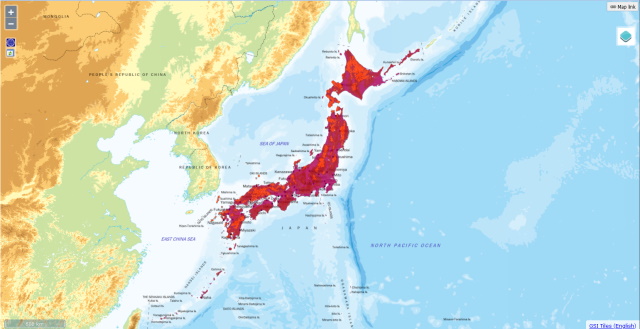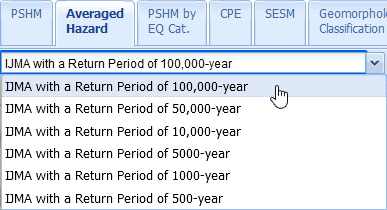Averaged Hazard Map shows the expected intensities of earthquake ground motions with long-term return period such as 500-100,000 years. The map is created to represent an effect of earthquake that has relatively low probability but could cause strong motion. All of earthquakes in the map are evaluated as Poisson process in seismic activity model. For example, a map of "Return Period of 1,000-year", which is equivalent to "3% Probability of Exceedance in 30 Years" in PSHM shows distribution of intensities that will possibly experience once in 1,000 years.
The number of earthquakes involved varies strongly depending on the return period. Effects of earthquakes with lower frequency are covered as the return period increases.
-Earthquakes around Japan can be cataloged by the return periods as:
- 1,000-year: Major subduction-zone earthquakes
- 10,000-year: Almost all of subduction-zone earthquakes and earthquakes on major active fault zones
- 100,000-year: Almost all of earthquakes including those of without specified source faults
Even if each of occurrence frequency is once in 100,000 years, an earthquake will occur once in 10 years on anywhere around Japan if there are 10,000 such earthquakes.
Following facts may be helpful to understand the long-term return period.
The number of destructive earthquakes occurred in Japan (death toll over 50) in the past 200 years is known as 23 times and its occurrence frequency is about once in 10 years.
It corresponds to each of occurrence frequency is once in 100,000 years.
Maps of Averaged Hazard are displayed by selecting the tab "Averaged Hazard".
You can select a type of map from the combobox on the toolbar.
 and the window which shows the summary of Averaged Hazard appears.
and the window which shows the summary of Averaged Hazard appears.


 and the window which shows the summary of Averaged Hazard appears.
and the window which shows the summary of Averaged Hazard appears.